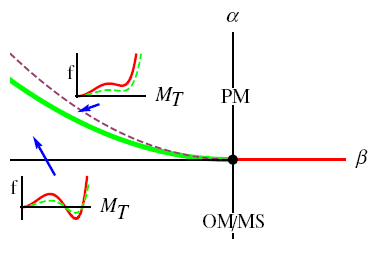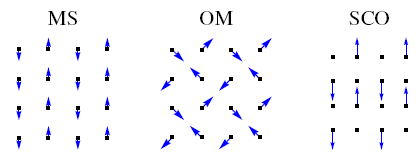Competing orders in Iron based superconductors
In January 2008 a new family of superconductors has been discovered with FeAs layers. Iron is a magnetic ion and in traditional superconductors small amounts of magnetic impurities kill superconductivity so an iron based superconductor is at first sight surprising.
Tc has grow rapidly beyond 50K opening a new gate to high-Tc superconductivity. In addition the phase diagram has some similarities with the cuprates which suggest that understanding the superconductors from this new iron age can help to solve the mistery of the supercundoctors from the copper age. Exotic superconductivity often appears in a phase diagram region where a uniform paramagnetic (PM) phase competes with charge or magnetic order. We have investigated magnetic order compeeting with superconductivity in FeAs layers using a simple Landau analysis. First we studied a simple microscopic model of the electronic structure and found that the transition is often first order but can become second order changing parameters like the doping. Interestingly experimentally there are compounds (known as 1111) that have a second order magnetic transition as a function of temperature and there are others that have a first order transition (known as 122). The point in which a transition line changes from first order to second order is known as a tricritical point. In Landau theory for a magnetic order parameter a tricritical point needs a quartic coefficient which changes from positive to negative. If alpha is the coefficient of the quadratic term and beta is the coefficient of the quartic term a tricritical phase diagram looks like this:

Tricritical point phase diagram showing a paramagnetic phase and magnetic phases (MS,OM). For the parameters chosen MS and OM phases are degenerate. The green line is first order whereas the red line is second order. The bullet indicates the tricritical point. The read line in the insets show the behavior of the free energy as a function of the local magnetic moment. The green dashed line is the free energy of a the metastable phase with spin and charge order (SCO).
Using symmetry arguments and the insight from the microscopic computations we have been able to identify all possible magnetic phases close to the tricritical point. We find only three phases all with interesting properties:
MS it the magnetic strpe or columnar phase alrredy identified in experiments. OM is a new phase which we call orthomagnetic. Magnetic moments are perpendicular to each other which is quite unusual. We are use to magnetic phases as described by Heisenberg models where magnetic moments are either parallel or antiparallel. In this new state electrons acquire a non trivial phase factor when circulating a plaquette which is reminiscent of the flux phase of cuprates. The last phase has spin and charge order (SCO) which is interesting because it introduces a natural link between charge fluctuations (potentially important for superconductivity) and magnetism.
We expects our results serve as a guide for experimentalists for possible phases to be detected in the future. We have pointed out that the SCO phase should be pined by impurities. The OM phase has the same static structural factor as the MS stripe phase so it can not be distinguish by a magnetic elastic scattering experiment alone. A fingerprint of the OM phase would be the absence of any lattice distortion which should be always be present in the MS phase.
After our work two groups have found the OM phase in LDA computations. See the article by Yndurain and Soler.
You can read our work published in Phys. Rev. Lett. here and in Nature Comm here.
People: C. Ortix, G. Seibold, M. Grilli, G. Giovannetti, M. Capone,J. van den Brink, José Lorenzana


